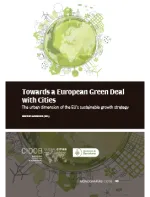Financing the green transition of European cities: what does the European Green Deal change?

The European Green Deal (EGD) is an ambitious set of policy initiatives aimed at reducing greenhouse gas (GHG) emissions to net zero by 2050 and moving the continent to a clean and circular economy (EC, 2019). Europe is one of the world’s most urbanised regions (UNDSA, 2019).1 Considering this, how will the EGD finance the transition to a climate-neutral, competitive and inclusive European economy at the city level? Generally, urbanisation has been good for human development and economic growth. Cities concentrate business, innovation and technology, and they facilitate access to food, infrastructure and healthcare. However, cities are also responsible for around 70% of human-induced GHG emissions (United Nations, 2020).
Financing urban, low-carbon infrastructure is a major challenge for cities in all regions of the globe, as they are dependent on many types of public actors (city governments, national governments, multilateral public funds) and private financial institutions. Slow urban growth in Europe presents particular challenges for the green transition. European cities face less pressure for new infrastructure than cities in developing countries, but must adapt existing infrastructure to low-emission patterns. This will demand specific types of financing and business models to achieve the rapid turnover required.